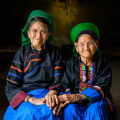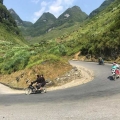How To Do The Ha-Giang Loop
Not only were we enchanted by the Ha Giang motorbike loop surroundings, but also the indigenous people and Vietnamese culture in this region.
We stayed in tiny villages with locals who treated us like family and allowed us to experience their extraordinary day to day lives away from industrial civilization.
(Nothing screams culture shock quite like witnessing 9-year-old children drive motorbikes on mountain roads, innocent toddlers play contently alongside a cliff edge, or admirable mothers carry out hard labor with babies strapped to their backs.)
Unlike neighboring Sapa, the Ha-Giang loop has gone under the radar of the backpacking trail in Viet nam, hidden from the millions of tourists who visit the country every year.
Subsequently, the curious nomads who do venture to the Ha-Giang province are rewarded with raw, authentic, and off the beaten path adventure.
In this article, I will be sharing our daily itinerary and experiences; this guide that will equip you with need-to-know information for a safe and enjoyable motorbike journey on the Ha-Giang loop.

What to know before you Motorbike the Ha-Giang Loop
The next few sections will provide you with everything you need to know about motorbiking in Vietnam on the Ha Giang loop route. Keep these three very important considerations in mind:
- Most locals do not English, so we recommend learning a few key phrases in Vietnamese. Use an offline google translate app on your phone and consider buying a Vietnamese travel phrase book.
- Although we had a local sim card, we struggled to find cell signal on the road. Make sure to have offline maps and an offline translation app.
- Good wifi is easy to find in hotels, homestays, and restaurants.
What to Pack For the Ha-Giang Loop

What you need to prepare
Although your standard packing for traveling Vietnam should suffice, there are a few key extra essentials to take. Below is a list of what to pack for the Ha-Giang loop in Vietnam:
Small to Medium sized backpack. You can usually leave your large luggage with your hotel or guest house.
- Small daypack
- Enough clothes for 3-5 days, bearing in mind you will get dirty along the drive
- Good-quality closed-toes travel shoes such as trainers or boots
- Any medication you might need
- Swimsuit and Towel for the waterfall
- Waterproof jacket and backpack cover
- Camera/GoPro
- Phone with mobile data
- A Ha Giang loop map – we suggest an offline Google/Maps.Me app or a paper map
- Contact details of your hostel or somebody you can contact in case of emergency.
- Battery Pack/Chargers
- Sunscreen
- Sunglasses
- Toiletries
- First Aid Kit
- Sufficient cash (although there are ATMs along the route)
How to get to Ha-Giang, Vietnam
The easiest way to access Ha-Giang is to take a bus from Hanoi. The journey time is approximately 6-7 hours and there are morning or evening buses available. As a guideline, we paid 250,000 VND to 450,000 for this service. We also recommend packing earplugs for the journey! A Ha Giang motorbike can usually be arranged upon arrival.

Best Time to Visit Ha-Giang
If you are wondering when is the best time to visit Ha-Giang, October through to April are considered the best months to visit Ha-Giang as it is dry season and the roads are safer to drive.
Where to Rent a Bike in Ha-Giang
Although there are a number of Ha Giang motorbike rental rental shops in Ha Giang town, we highly recommend Quiri Peninsula Hostel. The bikes are in perfect condition and they also provide all the accessories you will need, such as straps, gloves, helmet etc. If you take a Ha Giang loop tour through an agency they will provide a bike.
They will give you a detailed map of the loop, plus a ton of useful information and recommendations for along the way. They also provide free motorbike lessons for those who aren’t so confident on a bike.
Below are the bikes available along with the daily rental prices
- 125cc Automatic – 350,000 VND
- 110cc Semi-Automatic – 200,000 VND
- 125cc Manual – 250,000 VND

-
TIP: Although it is possible to complete the drive on a powerful automatic, it is recommended that you take either a semi-automatic or manual bike. The reason being, you will have more control over the demanding conditions of the mountain roads.
If this is your first time on a geared bike, do not fear. We had only ever driven an automatic before we got to Ha Giang, however, a short lesson on a semi-auto from the staff at our hostel had us feeling like pros in no time.
How to Drive the Conditions of the Ha-Giang Loop
It is important to note that the drive can be challenging at times, especially if you do not have much experience riding a motorbike. The roads can be extremely narrow, and scaling a cliff edge while mighty construction vehicles squeeze by can be somewhat nerve-racking.
You should be prepared for bad road conditions, steep inclines, and sharp hairpin bends.
The key is to keep your cool and drive within your limits. We witnessed a few accidents along the drive, thankfully none too serious, though they were usually due to speeding.
Take your time and appreciate the picturesque surroundings; not only will it be a safer journey but a more enjoyable one as well.
Tip: If you do not feel confident riding a bike yourself, there is an option to hire a driving guide while you ride in a buggy on the back. We recommend that you contact Bong Hostel in advance to check availability.

-
How much does the Ha-Giang Loop Cost?
Thankfully, completing the loop is financially achievable for all of you broke backpackers. Below you can find a breakdown of our approximate daily spending. The total per person per day was about 3,500,000 VND, equivalent 150$
I hope that with the experience above, it can help you prepare well for your trip.






